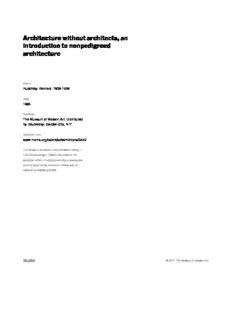Table Of ContentAArrcchhiitteeccttuurree wwiitthhoouutt aarrcchhiitteeccttss,, aann
iinnttrroodduuccttiioonn ttoo nnoonnppeeddiiggrreeeedd
aarrcchhiitteeccttuurree
Author
Rudofsky, Bernard, 1905-1988
Date
1964
Publisher
The Museum of Modern Art: Distributed
by Doubleday, Garden City, N.Y.
Exhibition URL
www.moma.org/calendar/exhibitions/3459
The Museum of Modern Art's exhibition history—
from our founding in 1929 to the present—is
available online. It includes exhibition catalogues,
primary documents, installation views, and an
index of participating artists.
MoMA © 2017 The Museum of Modern Art
ARCHITECTURE WITHOUT ARCHITECTS
by Bernard Rudofsky
128 pages, 156 illustrations $6.95
Architecture Without Architects
by Bernard Rudofsky
In this book Bernard Rudofsky steps outside the narrowly de
fined discipline that has governed our sense of architectural
history, and discusses the art of building as a universal phe
nomenon. By avoiding the geographical and social prejudices
that have obscured what he views as a total picture of architec
ture, he offers us glimpses of worlds that were hitherto unknown
and, indeed, unsuspected. A prehistoric theater district for a
hundred thousand spectators on the American continent, and
underground towns and villages (complete with schools, offices,
and factories) inhabited by millions of people are among the
unexpected phenomena he brings to light. In short, Architec
ture Without Architects, introduces the reader to communal
architecture—architecture produced not by specialists but by the
spontaneous and continuing activity of a whole people with a
common heritage, acting within a community of experience.
The beauty of this "primitive" architecture has often been dis
missed as accidental, but today we recognize in it an art form
that has resulted from human intelligence applied to uniquely
human modes of life. Indeed, Dr. Rudofsky sees the philosophy
and practical knowledge of the untutored builders as untapped
sources of inspiration for industrial man trapped in his chaotic
cities. The wisdom to be derived from them, he feels, goes be
yond economic and esthetic considerations, and touches the far
tougher problem of how to live and let live, of how to keep
peace with one's neighbors in the parochial sense and in the
universal one, as well.
Architect, engineer, and critic, Dr. Bernard Rudofsky is well
known for earlier books that approach the familiar from an un
conventional viewpoint—among them, Are Clothes Modern?
(a revelation of the irrationality of our coverings), The Kimono
Mind (an informal guide to the Japanese mentality) , and
Behind the Picture Window (in which he confronts what he
himself has dubbed "Uncle Sam's Cabin"). Viennese by educa
tion, New Yorker by choice, Dr. Rudofsky keeps his spirits high
by engaging in travels that last for years, and his own experi
ence with human accommodations runs the gamut from troglo
dyte dwellings to the emperor's suite in a Japanese mansion.
He is now at work expanding his study of non-pedigreed archi
tecture into a book on the universal problems of human shelter.
The Museum of Modern Art
11 West 53 Street, New York, N. Y. 10019
Distributed by Doubleday & Co. Inc., Garden City, N.Y.
THE MUSEUM
OF MODERN ART
hhh
mmhhmmihhhmi
ARCHITECTURE WITHOUT ARCHITECTS
7 5"2 _
ARCHITECTURE WITHOUT ARCHITECTS
An Introduction to Non-Pedigreed Architecture
by Bernard Rudofsky
The Museum of Modern Art, New York
Distributed by Doubleday & Company, Inc., Garden City, New 1 ork
I 2-^4
M(Mft
16 1-
Trustees of the Museum of Modern Art
David Rockefeller, Chairman of the Board; Henry Allen Moe, Vice-Chairman; William
S. Paley, Vice-Chairman; Mrs. Bliss Parkinson, Vice-Chairman; William A. M. Burden,
President; James Thrall Soby, Vice-President; Ralph F. Colin, Vice-President; Gardner
Cowles, Vice-President; Alfred H. Barr, Jr., *Mrs. Robert Woods Bliss, *Mrs. W. Murray
Crane, John de Menil, Rene d'Harnoncourt, Mrs. C. Douglas Dillon, Mrs. Edsel B. Ford,
Mrs. # Simon Guggenheim, Wallace K. Harrison, Mrs. Walter Hochschild, *J ames W.
Husted, Philip C. Johnson, Mrs. Albert D. Lasker, John L. Loeb, Mrs. Henry R. Luce,
Ranald H. Macdonald, Porter A. McCray, #Mrs. G. Macculloch Miller, Mrs. Charles S.
Payson, *Duncan Phillips, Mrs. John D. Rockefeller 3rd, Nelson A. Rockefeller, *Paul J.
Sachs, Mrs. Wolfgang Schoenborn, Mrs. Donald B. Straus, G. David Thompson, *Edward
M. M. Warburg, Monroe Wheeler, John Hay Whitney.
* Honorary Trustee
© 1964, The Museum of Modern Art, 11 West 53rd Street, New York, N.Y. 10019
Library of Congress Catalogue Card No. 64-8755
Designed by Bernard Rudofsky
Printed in the U.S.A. by Connecticut Printers, Inc., Hartford, Connecticut
Acknowledgements
The exhibition Architecture Without Architects, shown at the Museum of Modern
Art from November 9, 1964 to February 7, 1965, was commissioned by the Depart
ment of Circulating Exhibitions under the auspices of the International Council
of the Museum of Modern Art. Both the exhibition and the accompanying pub
lication were prepared and designed by the author, Consultant to the Department
of Architecture and Design.
The John Simon Guggenheim Memorial Foundation and the Ford Foundation
helped to finance the research for this project by awarding fellowships to the
director of the exhibition for a study of non-formal, non-classified architecture.
These grants might never have been given without the enthusiastic recommenda
tions of the architects Walter Gropius, Pietro Belluschi, Jose Luis Sert, Richard
Neutra, Gio Ponti, Kenzo Tange, and the Museum's Director, Rene d'Harnon-
court, all of whom hail from countries rich in vernacular architecture.
Sincere thanks go to the many people, too numerous to list here, who contrib
uted to this project in various ways. Special tributes, however, are due to Mme.
Rene Heyum, Musee de l'Homme, Paris; Miss Ruth M. Anderson, The Hispanic
Society of America, New York; the staff of the Frobenius Institute, Frankfurt, and
Dr. Myron B. Smith, Islamic Archives, Washington. Research assistance was ren
dered with exemplary patience by Miss Ellen Marsh. Credits for photographs,
many of which were generously donated, are listed on page 138.
Bernard Rudofsky
Description:The impious who prefer to turn to science in their quest for the origins of archi tecture will Caves, having been among man s earliest .. gained by being hoisted in a basket—the prototype of our elevators secret chambers, of murky passages and vertiginous flights of steps—all the eternal myste

